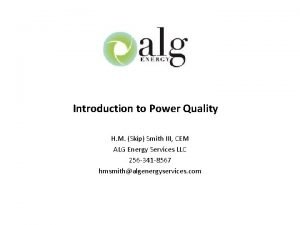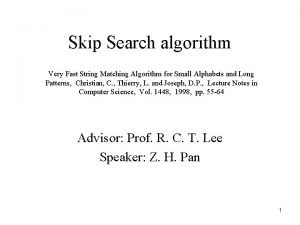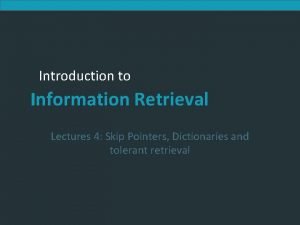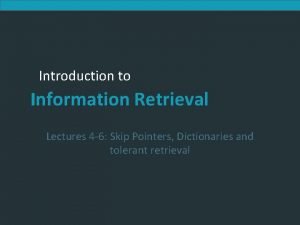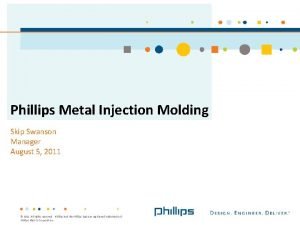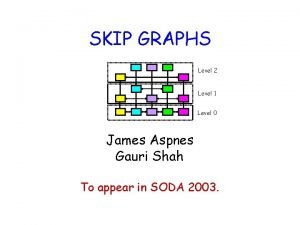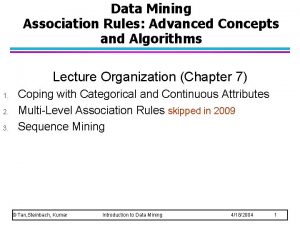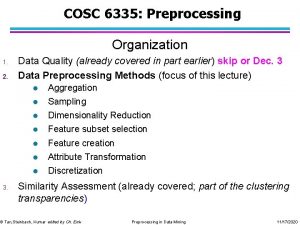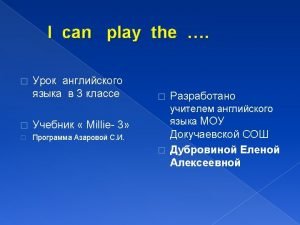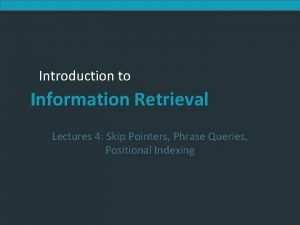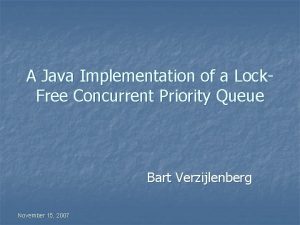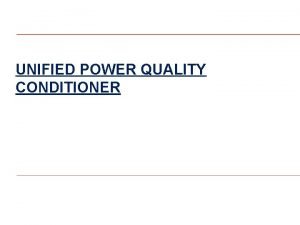Introduction to Power Quality H M Skip Smith































- Slides: 31

Introduction to Power Quality H. M. (Skip) Smith III, CEM ALG Energy Services LLC 256 -341 -8567 hmsmith@algenergyservices. com

Introduction to Power Quality Our world has become so deeply dependent upon the continuous availability of electrical power. Today’s technology demands power that is free of interruptions or disturbances. In recent years, there has been an increased emphasis on the quality of power delivered. This applies to factories, municipalities, government entities, commercial and institutional establishments, as well as residential. The term “power quality” has become one of the most prolific buzzwords in the power industry. It’s an umbrella concept for a multitude of individual types of power system disturbances. The issues that fall under this umbrella are not necessarily new. What is new is that engineers are now attempting to deal with these issues using a system approach rather than individually. There are four major reasons for the increased concern: 1. A newer-generation of load equipment, with microprocessor-based controls which are increasingly sensitive to power quality variations than in the past. 2. The increasing emphasis on overall power system efficiency to reduce costs which has resulted in continued growth in the application of devices such as variable speed drives (VFD), programmable logic controls (PLC) and power factor correction to reduce losses and improve production. This resulting in the degradation of power systems. 3. End users have an increased awareness of power quality issues. Utility customers are becoming better informed about such issues such as interruptions, sags, and switching transients. 4. Many things are now interconnected in a network. Integrated processes mean that the failure of any component has much more important consequences.

What Causes Power Quality issues? There are many misunderstandings regarding the causes of power quality problems. The charts below show the results of one survey conducted by the Georgia Power in which both utility personnel and customers were polled about what causes power quality problems. While surveys of other market sectors might indicate different splits between the categories, these charts clearly illustrate one common theme that arises repeatedly in such surveys: The utility’s and customers perspectives are often much different. While both tend to blame about two-thirds of the events on natural phenomena (e. g. , lightning), customers, much more frequently than utility personnel, think that the utility is at fault. Customer Perception Utility Perception Natural Utility Customer Neighbor Other

What is Power Quality? There can be completely different definitions for power quality, depending on your frame of reference. For example: A utility may define power quality as reliability and show statistics demonstrating that there system is 99. 98 % reliable. A criteria established by regulatory agencies. “An assumption”. An equipment manufacturer may define power quality as those characteristics of the power supply that enable their equipment to work properly and/or within their performance specifications. Power quality is ultimately a consumer-driven issue, and the end user’s point of reference takes precedence.

What is a power quality problem? Any power problem manifested in voltage, current, or frequency deviations that result in failure or misoperation of customer equipment. Some common symptoms are: • Unexplained equipment trips or shutdowns. • Occasional equipment damage or component failures. • Erratic control of process performance. • System crashes and equipment failures • Random lockups and data errors. • Power system component overheating These problems can be complicated

Power Quality issues cause businesses problems. • • • Equipment downtime resulting in loss of productivity Material waste, idle people & equipment. System crashes and equipment failures Lost orders and good will, Lost customers and profits Lost transactions and orders not being processed Revenue and accounting problems Overtime required to make up for lost work time Customer and/or management dissatisfaction.

Power Quality Can be Expensive – Berkeley Lab Study Estimates $80 Billion Annual Cost of Power Interruptions … Research News, Berkeley Lab, February 2, 2005 – $50 billon per year in the USA is lost as a results of power quality breakdowns …. Bank of America Report – A manufacturing company lost more than $3 million one day last summer in Silicon Valley when the “lights went out. ” … New York Times January 2000 – “A voltage sag in a paper mill can waste a whole day of production - $250, 000 loss” … Business Week, June 17, , 1996 – Half of all computer problems and one-third of all data loss can be traced back to the power line … Contingency Planning Research, LAN Times

Ideal Voltage Waveforms Single Phase Ideal power quality for the source of energy to an electrical load.

Ideal Waveforms Three (3) Phase

Ideal & Non-ideal Waveforms

Linear & Nonlinear Loads When voltages are applied to electrical loads, the load currents will have frequency and amplitudes dependent on the impedance or other characteristics of the load. A linear load is one where voltage (a sine wave) is applied across a constant resistance resulting in sinusoidal load current (another sine wave). A nonlinear load is one where voltage (a sine wave) is applied across a changing impedance resulting in distorted load current (distorted waveform). The load current with distorted waveforms can produce distortion of the voltage in the supply system, which is an indication of poor power quality. Devices that are converting alternating current (AC) to direct current (DC), is the most common nonlinear load found in electrical systems. It is used in equipment that ranges from 100 -W personal computers to 10, 000 -k. W adjustable speed drives.

Sources of Power Quality Problems Utility Sources • Lightning • Power Factor Correction Equipment • Faults • Switching Internal Sources • Individual Loads – Lighting, Elevators, Coolers, HVAC • Uninterruptable Power Supplies (UPS) • Variable Frequency Drives (VFD) • Battery Chargers • Large Motors During Start up • Electronic Dimming Systems • Electronic Ballasts/Drivers • Arc Welders, other Arc Devices • Medial Equipment, e. g. MRI’s and X-Ray Equipment • Office Equipment and Computers • Wiring

The Definition of Power Quality As previously defined: Any power problem manifested in voltage, current, or frequency deviations that result in failure or misoperation of customer equipment. Power quality loosely defined: is the study of powering and grounding electronic systems so as to maintain the integrity of the power supplied to the system. IEEE 100 Authoritative Dictionary of IEEE Standard Terms: The concept of powering and grounding electronic equipment in a manner that is suitable to the operation of that equipment and compatible with the premise wiring system and other connected equipment. Standard Handbook of Electrical Engineers: Good power quality, however, is not easy to define because what is good power to a refrigerator may not be good enough for today’s personal computers and other sensitive loads. For example, a short outage would noticeably affect motors, lights, etc. but could cause a major nuisance to digital clocks, computers, etc.

Power Quality Standards IEEE Standards 519 and 1159 Standards are needed so all end users (industrial, commercial, and residential) and transmission and distribution suppliers (the utilities) speak the same language when discussing power-quality issues. Standards also define recommended limits for events that degrade power quality. IEEE Standards are publications that provide acceptable design practices as well as a common language. IEEE Standard 519: Recommended Practice and Requirements for Harmonic Control in Electrical Power Systems. Establishes goals for the design of electrical systems that include both linear and nonlinear loads. IEEE Standard 519 is twofold. 1. The utility has the responsibility to produce good quality voltage sine waves. 2. The end user customers have the responsibility to limit the harmonic currents their circuits draw from the line. IEEE Standard 1159: Recommended Practice for Monitoring Electric Power Quality. Covers the monitoring of electrical characteristics of single-phase and polyphase (three-phase) AC power systems.

Power Quality Terms Some ambiguous terms: • Blackout/Brownout • Bump • Power Surge • Clean Power • Surge • Outage • Blink • Dirty Power • Spike/Wink • Raw Power • Glitch IEEE Defined power quality disturbances: • Transients • Interruptions • Sag/Undervoltage • Swell/Overvoltage • Waveform distortion • Voltage Fluctuations • Frequency Variations

Examples of Poor Power Quality Impulse & Oscillatory Transients: are a brief, unidirectional (impulse) and bidirectional (Oscillatory) variation in voltage, current or both on a power line. The most common causes: • Impulsive transients is lightning strikes, poor grounding, electrostatic discharge (ESD), switching inductive loads, or switching in power distribution system. • Oscillatory transients can occur due to the switching of power factor correction capacitors, or etc. These occur when you turn off an inductive or capacitive load, such as a motor or capacitor bank. The #1 reason out of 13 for motor failures. Potential effects: Loss or corruption of data, possible damage, system halts.

Examples of Poor Power Quality Interruption: is defined as a reduction in line-voltage or current to less than 10% of the nominal, not exceeding 60 seconds in length. The most common causes: power grid damage, lightning strikes, animals, trees, vehicle accidents, destructive weather, equipment failure, or circuit breaker tripping. • Momentary 30 cycles – 3 seconds • Temporary 3 seconds – 1 minute • Sustained > 1 minute Potential effects: loss of data, system damage and /or shutdown

Examples of Poor Power Quality Voltage Sag/Undervoltage: a brief decrease in the rms line voltage of 10 to 90% of nominal line voltage. The most Common causes: The starting of large induction motors and/or the -initial starting of large air conditioning systems. • Instantaneous 0. 5 – 30 cycles • Momentary 30 cycles – 3 seconds • Temporary 3 seconds – 1 minute Potential effects: System halts, loss of data, system damage and /or shutdown

Examples of Poor Power Quality Voltage Swell/Overvoltage: is the converse to the swag. A swell is a brief increase in rms line-voltage of 110 to 180% of nominal line voltage. The common causes: are line faults and incorrect tap settings in tap changers in substations due to reduction of loads. • Instantaneous 0. 5 – 30 cycles • Momentary 30 cycles – 3 seconds • Temporary 3 seconds – 1 minute Potential effects: Nuisance tripping, equipment damage/reduced life

Examples of Poor Power Quality Voltage distortion – defined as a steady-state deviation from an ideal sine wave of power frequency principally characterized by the spectral content of the deviation. There are five (5) primary waveform distortions: DC offset, Notching, Harmonics, Inter-harmonics, and Noise The #3 reason out of 13 for motor failures. DC Offset Notching

Examples of Poor Power Quality Voltage Distortion (Cont. ) Harmonics: the corruption of the fundamental sine wave at frequencies that are multiples of the fundamental frequency (60 Hz. ). This is due to nonlinear characteristics of devices and loads on the power system. Symptoms include: overheated transformers, neutrals conductors, and other electrical equipment as well as circuit breaker & nuisance tripping

Examples of Poor Power Quality Voltage Distortions (Cont. ) Total Harmonic Distortion (THD) is the sum of the contributing harmonics. Harmonic distortion is a normal consequence of a power system supplying electronic loads such as computers, electronic ballast/drivers, adjustable speed drives, and other control systems. Symptoms include: • High current to flow in neutral conductors • Motors and transformers to run hot, shortening their lives • Increased susceptibility to voltage sags/undervoltage • Reduced efficiency of transformers • Audible noise Harmonics are a mathematical way of describing distortion to a voltage or current waveform.

Examples of Poor Power Quality Voltage imbalance: is a variation in the amplitudes of three-phase voltages, relative to one another. This can be caused by different loads on the phases, resulting in different voltage drops through the phase-line impedances. The #2 reason out of 13 for motor failures.

Examples of Poor Power Quality Voltage Imbalance (Cont. ) In a balanced three (3) phase system, the phase voltages should be equal or very close to equal. Imbalance is the measurement of the inequality of the phase voltages. Voltage imbalance can cause three (3) phase motors and other 3 phase loads to experience poor performance or premature failure because of the following: • Mechanical stresses in motors due to lower than normal torque output. • Higher than normal current in motors and 3 phase rectifiers. • Imbalance current will flow in neutral conductors in 3 phase wye systems.

Power Quality Costs. Example calculation voltage imbalance costs: The major costs are associated with motor replacement (labor + material) and lost income due to circuit protection trips. Assume the cost to replace a 50 hp. motor each year is $5, 000 including labor. Assume 4 hours of downtime per year with income loss of $6, 000 per hour. Total Costs: $5, 000 + (4 x $6, 000) = $29, 000 annually. Example calculation total harmonic distortion: The major costs are associated with shortened life of motors and transformers. If the equipment is part of the production systems, income may be affected as well. Assume the cost to replace a 100 k. VA transformer is $7, 000 including labor each year. Assume 8 hours of downtime each year with income loss of $6, 000 per hour. Total Costs: $5, 000 + (8 x $6, 000) = $53, 000 annually.

Power Quality Fun Facts The 13 common causes of motor failures. 1. Transient voltages: can come from a number of sources either inside or outside of the plant. The impact: motor winding insulation breakdown which leads to early motor failure and unplanned downtime. 2. Voltage imbalance: Three (3) phase distribution systems often serve single-phase loads. An imbalance in impedance or load distribution can contribute to imbalance across all three of the phases. The impact: creates excessive current flow in one or more phases that then increases operating temperatures-leading to insulation breakdown and overloading of the neutral conductor. 3. Harmonic distortion: are any unwanted additional source of high frequency AC voltages or currents supplying energy to the motor windings. This additional energy is not used to turn the motor shaft but circulates in the windings and ultimately contributes to internal energy losses such as heat. The impact: Decreases in motor efficiency results in added cost and an increase in operating temperatures. 4 -6. Variable Frequency Drives – (PWM Signals, Sigma currents, Operational overloads) 7 -13. Mechanical – (Misalignment, shaft imbalance, shaft looseness, bearing wear, soft foot, pipe strain, shaft voltage).

Power Quality Costs Recap • Power quality costs can show up in many aspects of industrial and commercial operations. Costs include: – Field service costs: undetected disturbance events that result in component or circuit board failures with no verifiable cause and where either the equipment manufacturer absorbs the repair costs or the customer must bear the costs. – Manufacturing costs: because some portion of certain manufacturing systems is affected by PQ disturbances, the whole system may not meet the performance requirements, product quality, production rates or production volumes. Then the manufacturers deem it necessary to purchase backup systems to avoid disturbances. – Productivity costs: usually impacted by both hidden and direct, or identifiable, costs, e. g. , idle manpower due to interruption, clean up operations, or corrective maintenance. – Loss of Revenue: any direct interruption to a manufacturing process – Decreased competitiveness: PQ problems resulting in customer dissatisfaction and poor quality products – Lost opportunity: PQ problems that impact products or service. – Product damage: PQ problems can result in product damage. – Wasted energy: any interruption to a process – Decreased equipment life: PQ disturbances can have a degradating influences on production equipment.

Power Quality Investigation The keys to understanding power quality events. • Identifying what sensitive electronic equipment is experiencing problems (e. g. , type, location). • Document the types of equipment malfunctions or failures (e. g. , data loss, lockups, component damage). • Determine when the problems occur (e. g. , time of day, day of week, particular system operation). • Establish those coincident problems occurring at the same time. (e. g. , lights flicker, motors slow down). • Investigate possible problems sources at site ((e. g. , arc welders, air conditioning, copy machines, and any equipment with rectifier input power supplies). • Make inquiries regarding existing protection for equipment. (e. g. , transient voltage surge suppressors, isolation transformers, internal filtering circuit devices, etc. ).

Power Quality Economic Evaluations Measures can be taken to improve the power quality of a given circuit or facility. The economic feasibility of the applications should be considered as well. The system compatibility must be examined to determine the behavior of a customer’s equipment within the electrical environment. A power quality investigation and an economic analysis can then determine what mitigation tactics are most effective and whether they should be applied. Using the information gathered in the aforementioned investigation will assist in determining the power conditioning equipment most effective for the problem. Monitoring should assist in determining what type of phenomenon (e. g. , sags, transients) are causing the problems. Data from the monitoring will give an idea as to how often the problem events are occurring. Economic analysis is essential. Cost of the disturbance? Vs. Costs of the solution?

Introduction to Power Quality Thank you ALG Energy Services LLC H. M. (Skip) Smith III, CEM Sr. Electrical Engineer hmsmith@algenergyservices. com 256 -341 -8567

References Dugan, Roger C. , Mark F. Mc. Granaghan, Durya Santoso, and H. Wayne Beaty. Electrical Power Systems Quality, 3 rd eds. The Mc. Graw Hill Company Kusko, Alexander, and Marc T. Thompson. Power Quality in Electrical Systems, The Mc. Graw Hill Company Thumann, Albert, and Scott Dunning. Plant Engineers and Managers Guide to Energy Conservation, 10 th eds. – The Fairmont Press, Inc. Seymour, Joseph, “The Seven Types of Power Problems. ” White Paper 18, Schneider Electric – Data Center Science Center Fluke Application Notes: “The Costs of Poor Power Quality” “Basic Power Quality Methodology and Common Culprits” “Common Power Quality Factors Affecting Transformers” ELSPEC North America True RMS Measurements Power Quality Self –assessment Guide Application Note: Dynamic Reactive Power Compensation & Harmonic Filtrations
 Skip pointer
Skip pointer Introduction to power quality
Introduction to power quality Power trianlge
Power trianlge Skip rochefort
Skip rochefort Skip osu
Skip osu Skip tracing definition
Skip tracing definition Fastest string search algorithm
Fastest string search algorithm Skip counting on number line
Skip counting on number line Skimming and scanning in reading comprehension
Skimming and scanning in reading comprehension Randomized skip list
Randomized skip list Skip pointer
Skip pointer Which is a good idea for using skip pointers
Which is a good idea for using skip pointers Skip list in python
Skip list in python Difference between hashing and skip list
Difference between hashing and skip list Skip list
Skip list Skimming skill
Skimming skill Skip swanson
Skip swanson Pant i skip
Pant i skip Skip graph
Skip graph Skip the games
Skip the games Colour 200519
Colour 200519 Mining skip
Mining skip Mining skip
Mining skip Skip through the seasons
Skip through the seasons Skip graph
Skip graph Skipdraw
Skipdraw Skip pointers
Skip pointers Skip tyler white house down
Skip tyler white house down Skip this
Skip this Skip coleman
Skip coleman Java lock free
Java lock free Perform quality assurance
Perform quality assurance

